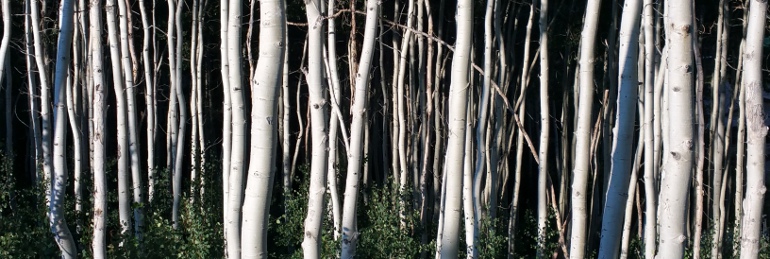| HOME | BLOG | CONNECT | SITE MAP | CONTACT |


|
| Aspens dominate the Western Hardwood forest type. |
|
Wasatch-Cache National Forest Utah's Wasatch-Cache National Forest is the place to experience the western hardwood forest type and get a flavor for a few other forest types. So far in Trip 1, in the Wind River range and in Yellowstone, the forests have been dominated by evergreens like lodgepole pines, Douglas firs and other firs and spruces. The western hardwood forest type is dominated by aspens, which are deciduous trees which lose their leaves in the Fall. There are definitely pockets of aspens in the Greater Yellowstone ecosystem but they are limited. In contrast, if you drive along highway 39 between Woodruff and Ogden in northern Utah, you will see a large area of forest with few trees besides aspens. It gives a very different feel than the darker evergreen forests. In trying to experience many organisms and environments, one goal of Experiencing Life is to visit each of the forest types described by the U.S. Forest Service. In Trip 1, there are two forest types that are the focus of the trip but many more that can be introduced. There aren't really any parts of the country more dominated by the lodgepole pine forest type than the Yellowstone area, so that type is a focus there. And aspens, or the western hardwood forest type, can be found all over the west, but few places are quite as dominated by the type than northern Utah. In addition to these two forest types, Greater Yellowstone is a place to be introduced to the Fir/Spruce type, found at higher elevations. This type is especially common at higher elevations in the Wind River range but it will be a focus in Trip 6, at Rocky Mountain National Park. The Douglas Fir forest type is not dominant but is relatively common all the way from Yellowstone to this part of Utah. It will be a focus of Trip 5, in the Pacific Northwest. The Ponderosa Pine type is rare but can be found scattered around Yellowstone. This type will be a focus of Trip 4, at the Grand Canyon. The Pinyon-Juniper forest type can be experienced as you approach the Great Salt Lake from the east, but it is another rare type in this area. It will also be focused upon at the Grand Canyon. Finally, a forest type that is almost not a forest can be experienced in pockets of the Wasatch-Cache. Chaparral is a thick, shrubby type of vegetation that is rare in most of the country except in southern California (Trip 7), which is where the type will be a focus.
|
|
Trip Menu |
|
Northern Utah Wasatch-Cache Map Sources
experiencinglifetrips@gmail.com |

